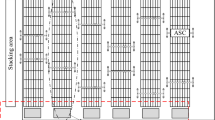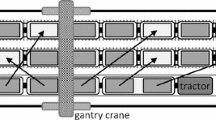Abstract
This paper considers a scheduling problem occurring in the hinterland of many medium-sized container ports. Here, containers from a storage yard need to be loaded onto freight trains by straddle carriers (SCs). The main complicating fact in the resulting train loading problem with straddle carriers (TLSC) is that the track provides only one-sided access and while straddling the train SCs cannot pass each other. This paper introduces the TLSC with two different policies to avoid obstructions of SCs in the track lane, settles computational complexity, and compares both policies in a comprehensive computational study.







Similar content being viewed by others
References
Bierwirth C and Meisel F (2010). A survey of berth allocation and quay crane scheduling problems in container terminals. European Journal of Operational Research 202 (3): 615–627.
Blazewicz J, Dell'Olmo P and Drozdowski M (1999). Scheduling of client-server applications. International Transactions in Operational Research 6 (4): 345–363.
Boysen N and Fliedner M (2010). Determining crane areas in intermodal transshipment yards: The yard partition problem. European Journal of Operational Research 204 (2): 336–342.
Boysen N, Fliedner M and Kellner M (2010). Determining fixed crane areas in rail-rail transshipment yards. Transportation Research Part E: Logistics and Transportation Review 46 (6): 1005–1016.
Brinkmann B (2011). Operations systems of container terminals: A compendious overview. In: Böse JW (ed). Handbook of Terminal Planning. Springer: Berlin.
Garey MR and Johnson DS (1978). ‘Strong’ NP-completeness results: Motivation, examples, and implications. Journal of the Association for Computing Machinery 25 (3): 499–508.
Garey MR and Johnson DS (1979). Computers and Intractability. W.H. Freeman: New York.
Hulett H, Will TG and Woeginger GJ (2008). Multigraph realizations of degree sequences: Maximization is easy, minimization is hard. Operations Research Letters 36 (5): 594–596.
Jeong BJ and Kim KH (2011). Scheduling operations of a rail crane and container deliveries between rail and port terminals. Engineering Optimization 43: 597–613.
Stahlbock R and Voß S (2008). Operations research at container terminals: A literature update. OR Spectrum 30 (1): 1–52.
Steenken D, Voß S and Stahlbock R (2004). Container terminal operation and operations research—A classification and literature review. OR Spectrum 26 (1): 3–49.
Author information
Authors and Affiliations
Corresponding author
Rights and permissions
About this article
Cite this article
Boysen, N., Emde, S. & Fliedner, M. Scheduling train loading with straddle carriers in container yards. J Oper Res Soc 64, 1841–1850 (2013). https://doi.org/10.1057/jors.2012.160
Received:
Accepted:
Published:
Issue Date:
DOI: https://doi.org/10.1057/jors.2012.160




